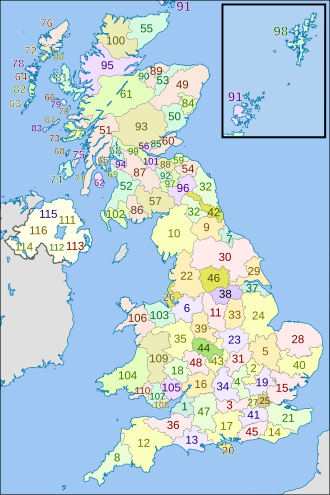Special post town
| Postal county | |
|---|---|
|
Also known as: Former postal county |
|
 |
|
| Category | Postal geography |
| Location | United Kingdom |
| Created | Major revision 1974 |
| Abolished | 1996 |
| Number | 116 (as of 1996) |
| Possible types | England (48) Northern Ireland (6) Scotland (54) Wales (8) |
| Subdivisions | Post town |
The postal counties of the United Kingdom, now known officially as the former postal counties, were postal subdivisions in routine use by Royal Mail until 1996. The of the postal county – as opposed to any other kind of county – was to aid the sorting of mail by enabling differentiation between like-sounding post towns. Since 1996 this has been done by using the outward code (first half) of the postcode instead. For operational reasons the former postal counties, although broadly based on the counties of the United Kingdom, did not match up to their boundaries, in some cases with significant differences. The boundaries changed over time as post towns were created or amended.
According to the Royal Mail, the former postal county data no longer forms part of postal addresses. It was removed from the Postcode Address File database in 2000 and does not form part of its code of practice for changing addresses. Despite this, county data is routinely sold to companies, ostensibly in order for them to cleanse their own address data. As the former postal county data was the last to be in routine use, some organisations have continued to use this obsolete data as part of postal addresses. In 2009 the Royal Mail code of practice consultation included discussion of the possibility of replacing the currently supplied 'alias data' with an up-to-date county information data field. In 2010 the regulator advised Royal Mail to cease supply of county data altogether, and a timetable has been put in place for this to occur between 2013 and 2016.
Counties were used in postal addresses from the earliest days of the Post Office, but over time the postal counties of many places did not match geographic counties or counties used for administrative purposes. There were several reasons for this:
Firstly, many of the approximately 1,500 post towns straddled county boundaries and the postal addresses of all places in such areas included the postal county of the post town regardless of their actual location. In a written answer in the House of Lords in 1963, Lord Chesham, Parliamentary Secretary at the Ministry of Transport estimated that about 7% of towns and villages with a post office lay in a postal county different from their geographical county. He went to explain that:
...
Wikipedia
